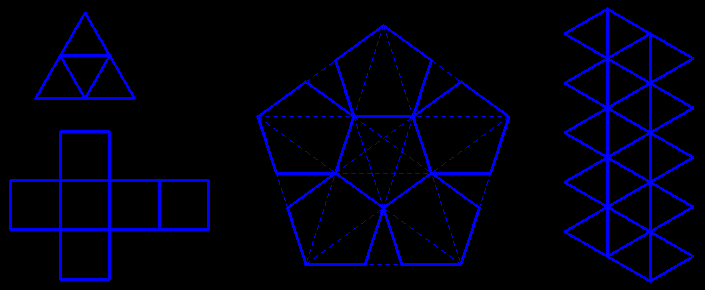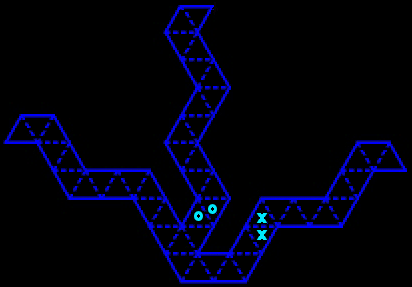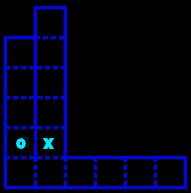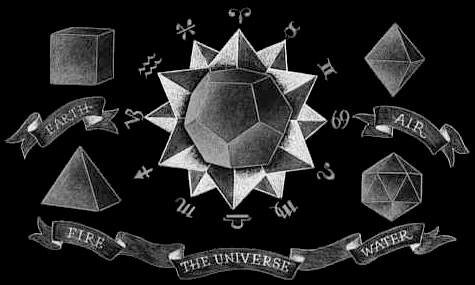
f regular faces
s vertices [order]
a edges
faces' angle
6 squares
8 [3]
12
90°
8 triangles
6 [4]
12
109°28'
4 triangles
4 [3]
6
70°32'
20 triangles
12 [5]
30
138°11'
12 pentagons
20 [3]
30
116°34'
The regular polyhedra are, in the space, the analogues of the regular polygons in the plane; their faces are regular and identical polygons, and their vertices belong to the same number of faces (regular and identical they are "regularly" distributed on a sphere). Their analogues in dimension four are the regular polytopes.
A polygon is convex if all its diagonals (segments joining two vertices and which are not sides) are inside. Likewise we recognize a convex polyhedron by the very fact that all its diagonals (segments which join two vertices and are not edges) belong to its inside or to its surface.
Whereas there exist an infinity of regular convex polygons, the regular convex polyhedra are only five.
| proof: | Each face has p sides (p>2), thus the value of each angle of the p-gon is (p-2)×180°/p
Each vertex is surrounded by q faces (q>2), thus the sum of q angles must verify q[(p-2)/p]×180° < 360° which is equivalent to (p-2)(q-2) < 4 with p and q strictly greater than 2. The symmetry in p and q let us suspect that there is a duality. The five solutions (3,3), (3,4), (4,3), (3,5) and (5,3) lead to the tetrahedron, the octahedron, the cube, the icosahedron and the dodecahedron. |
| remark: | These five polyhedra verify p×f = 2×e = q×v and Euler's formula s + f = a + 2 |
 | |||||
| name f regular faces s vertices [order] a edges faces' angle |
cube 6 squares 8 [3] 12 90° |
octahedron 8 triangles 6 [4] 12 109°28' |
tetrahedron 4 triangles 4 [3] 6 70°32' |
icosahedron 20 triangles 12 [5] 30 138°11' |
dodecahedron 12 pentagons 20 [3] 30 116°34' |
more information
|
|
• The regular octahedron's edges are the sides of three squares with the same center and orthogonal by pairs.
• Two opposite edges of a cube define a format A rectangle. The 8 vertices of a cube are those of three such rectangles which intersect at 60° on a 3-fold symmetry axis; thus there are 4 such arrangements. |
|
| The 30 edges of a regular icosahedron define 15 golden rectangles (sides in golden ratio φ). The 12 vertices of a regular icosahedron are in two ways the vertices of three golden rectangles:
• rectangles with same center and orthogonal by pairs; thus there are 5 arrangements of this well known classic type, (let's notice that the 12 vertices of the icosahedron belong to the faces of a cube; the ratio of the cube's edge to the icosahedron's edge is φ) • rectangles which intersect at 60° on a 3-fold symmetry axis; thus there are 10 arrangements of this type described by Sylvester (1844). |
||
|
• The 30 edges of a regular dodecahedron define 15 rectangles with sides in the ratio 1+φ=φ² (the ratio of the cube's edge to the dodecahedron's edge is φ).
12 vertices of a regular dodecahedron are the vertices of three such rectangles with same center and orthogonal by pairs; the 8 other vertices are those of a cube. There are 5 arrangements of this type. • The 20 vertices are also those of five rectangles which intersect at 36° on a 5-fold symmetry axis; thus there are 6 arrangements of this type. |
|
|
|
• Four vertices of a cube are the vertices of a regular tetrahedron; so we can make a regular tetrahedron by cutting four "corners" of a cube.
• The midpoints of the edges of a regular tetrahedron are the vertices of a regular octahedron. • Eight vertices of a regular dodecahedron are the vertices of a cube; so we can build a regular dodecahedron by gluing six "roof shaped" pentahedra on the faces of a cube (each pentagon is then made by a trapezium and a triangle, both isosceles and in the same plane). To get a dodecahedron with edge 1 we must assemble roofs with height 1/2 on the faces of a cube with edge the golden ratio φ. Then 12 of the 20 vertices of the dodecahedron belong to the faces of a cube with edge φ+1. |
|
|
The 30 edges of a regular icosahedron split into five groups of 6 edges two by two parallel or orthogonal; the midpoints of the edges of a group are the vertices of a regular octahedron.
If we transform this octahedron using an homothecy with ratio the golden ratio φ we get a second octahedron which faces contain 8 faces of the icosahedron; moreover the 12 vertices of the icosahedron divide the edges of this octahedron in the ratio φ. Remark: eight faces of the icosahedron have sides which don't belong to the group of six edges depicted in bold gray; the centers of these faces are the vertices of a cube (not depicted to don't overload the figure). |
|
In Book XIV (attributed to Hypsicles) of Euclid's Elements we find a curiosity: Let be a regular dodecahedron and a regular icosahedron inscribed in spheres with same radius, then the circles circumscribed to the their faces (pentagons and triangles) have also same radius, and their areas have same ratio as their volumes. Here are three others: | |
|
|
Ten vertices of a dodecahedron which don't belong to two opposite faces define two pentagons parallel to these faces; they cut the dodecahedron in three solids with same volume.
Robin Chapman gives an elementary proof of this result: it is sufficient to prove that one of the frustum of a pentagonal pyramid has a volume which is the third of those of the dodecahedron.
|
|
|
It exists a regular octahedron whose vertices lie on the edges of a cube. ( problem from the Tournament of Towns competition ) On the three edges starting on a vertex of the cube let be three points at a distance d from this vertex; in the same way we define three more points starting from the opposite vertex. Thus we have the six vertices of a non regular triangular antiprism with only equilateral bases (the six others faces are isosceles). By varying d we can deform the isosceles triangles until they become equilateral, and thus we get a regular octahedron. It is easy to verify that this is achieved for d equal to the three quarters of the cube's edge. |
|
|
There is a cube "inscribed" in a cube (only six of its vertices belong to the faces of the "circumscribed" cube).
Two vertices divide a diagonal d of the large cube in the ration 1:3:1, and the six others divide the face's diagonals stemming from the ends of d in the ratio 3:2. The ratio of the edges is 1.2. |
Nothing replaces the pleasure to build oneself these five elementary polyhedra. Here are their nets:
• regular tetrahedron: an equilateral triangle and its midpoints triangle; what's the other net of this tetrahedron?
• cube: six squares arranged in a "cross", but there exists other arrangements; could you find all the nets of the cube ?
• regular octahedron: two regular tetrahedron's nets (the midpoints triangles are opposite faces of the triangular antiprism),
• regular dodecahedron: the half template (six regular pentagons) is easy to draw using a large regular pentagon,
• regular icosahedron: ten of the twenty equilateral triangles form a stripe.
These nets are obviously not unique; here is a nice video (found on YouTube, 4:40 - 7.3 Mb) which gives an idea of the variety of the icosahedron's nets (you can continue your visit during the loading which may be long with a slow connection).

These five polyhedra can also be constructed by braiding together straight strips of paper with appropriate folds. If you require that
• each edge and each vertex must be covered by at least one thickness of strip,
• the strips used on a given model must be either identical or mirror images,
• and that the areas of the visible parts must be equal for all strips,
then to braid a tetrahedron, a cube, an octahedron, an icosahedron and a dodecahedron, you need respectively 2, 3, 4, 5 and 6 strips.
(proved by J. Pedersen during the Escher Congress, in 1985, in Rome).
| Here are two patterns which can be plaited like hairs. |
 | |
 |
To begin bring the "o" on the "x".
The pattern on the left leads to a cube (to strengthen the result stick the last square into the assembling). The one on the right gives an icosahedron (stick two ends of two triangles into the assembling to strengthen it). | |
Plato associated the convex regular polyhedra with the "elements": the octahedron and the tetrahedron with air and fire, the cube and the icosahedron with earth and water, and the dodecahedron, the closest to the sphere, with the universe (ether).

 |
 |
| references: |
• PlatonicSolids.info by Daniel Radin: a colorful fun site
• three applets: polyhedron explorer (Wolfram web Mathematica) - "syntheme" (Greg Egan) • Some polyhedral patterns by Robert Dawson • Icosahedron and phi: illustrated study by Angelos Fernandez Garcia and Montserrat Prieto Morera • Plato's polyhedra in space by Nicolas Hannachi and more interesting stuff! |
home page
 |
convex polyhedra - non convex polyhedra - interesting polyhedra - related subjects | November 1998 updated 17-11-2015 |